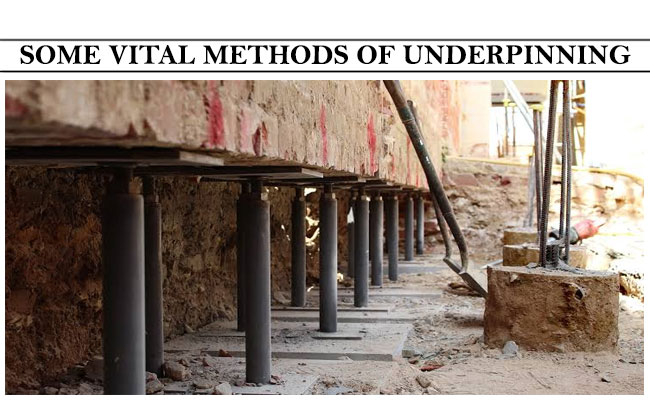Some vital methods of Underpinning

The foundation of a subsisting building or other structured in a construction is reinforced and stabilized with the underpinning method.
Existing building or other structure.
Underpinning method is applied on the following conditions:-
- The original foundation is not sufficiently strong or comparatively steady.
- The application of the structure is revised.
- The characteristics of the soil upon which the foundation is supported may have altered (probably through subsidence) or were not defined throughout the design.
- The construction of adjoining structures requires the excavation of soil that provides support to subsisting foundations.
- It is very cost-effective to operate on the existing structures foundation rather constructing a new one because of land price or otherwise.
Underpinning Method:-
Underpinning is performed by expanding the foundation deeply or widely in order that it either stands on a more supportive soil bed or circulates its load over a large area. In underpinning, micro piles and jet grouting are extensively utilized. A substitute to underpinning is reinforcing the soil with a grout. All of these methods are normally costly and complicated.
The underpinning is categorized as follow:-
- Mass Concrete Underpinning
- Beam and base underpinning
- Mini-piled underpinning
Mass Concrete Underpinning
It is also called conventional underpinning, This underpinning method fortifies the foundation of a current structures by excavating boxes manually below and progressively pouring concrete in a well-planned order. At the end, a foundation is constructed below the current foundation.
This underpinning method is normally utilized when the subsisting foundation remains at a shallow depth; although, the method is also effective even at fifty feet deep. The method is not modified from its beginning with its utilitarian tools like shovels and post whole diggers. Heavy machinery is not required in this method owing to the rigid nature of the boxes used for digging.
Beam and base underpinning
The beam and base method of underpinning requires more technically superior adapting. A reinforced concrete beam is built up underneath, over or in substitution of the current footing. The beam then transmits the load of the building to mass concrete bases, which are erected at designed strategic locations. Base sizes and depths are influenced by the existing ground conditions.
Beam design is based on the configuration of the building and the applied loads.
Mini-piled underpinning
Mini-piles contain the utmost value where ground conditions are continuously changing, where entrée is confining. Mini-piled underpinning is normally applicable if the loads generated from the foundations should be transmitted to stable soils at high depths normally over 5.0 metres. Mini-piles may either be augured or pushed steel cased, and usually remain among 150mm and 300mm in diameter.
Underpinning the foundations of a railway bridge with a timber box crib to provide support to the bridge. A finished concrete pad underpinning is found at the bottom right.

